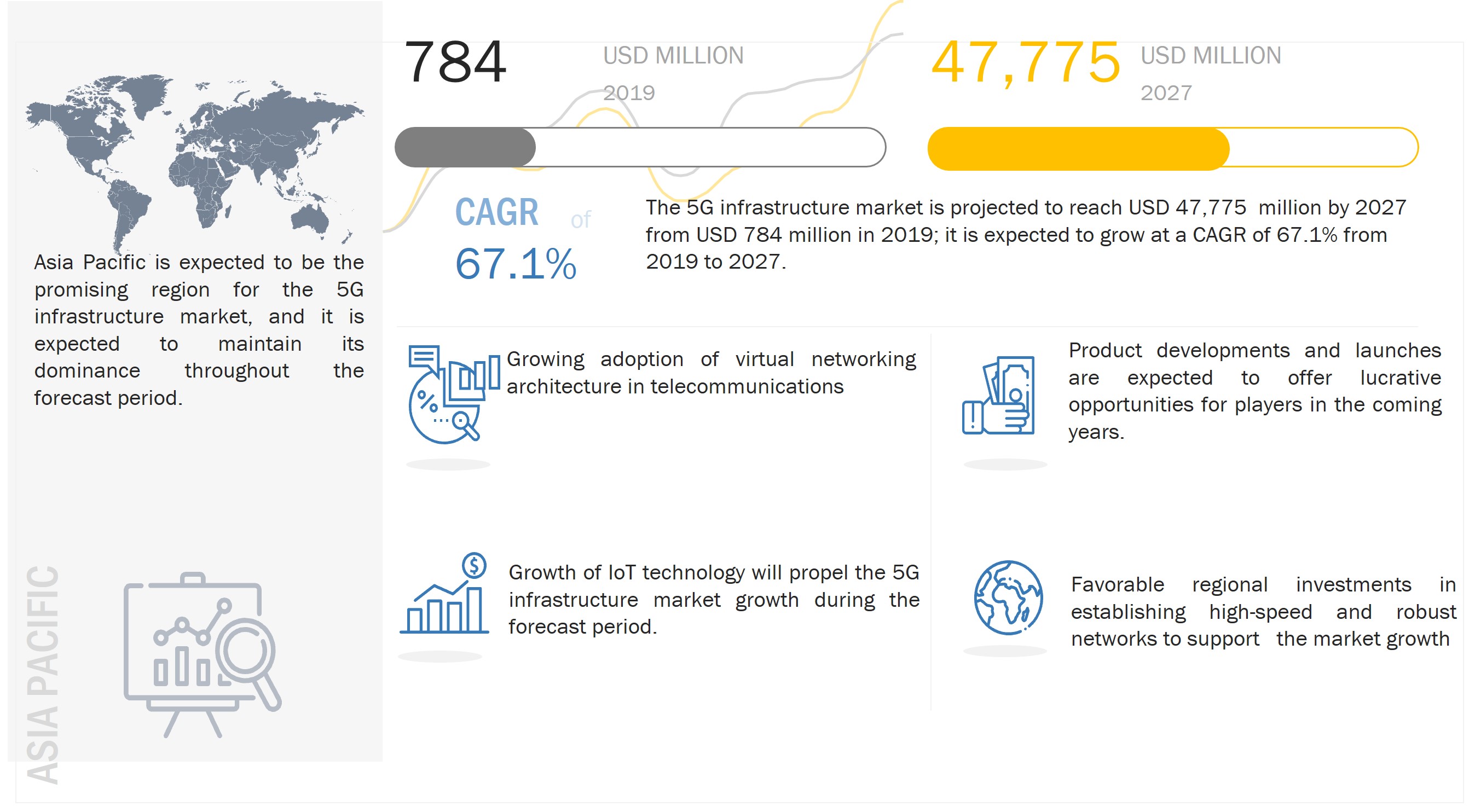The report “5G Infrastructure Market by Communication Infrastructure (Small Cell & Macro Cell), Core Network (SDN & NFV), Network Architecture (Standalone & Non-standalone), Operational Frequency (Sub 6GHz & Above 6GHz), End User & Geography – Global Forecast to 2027″ The 5G Infrastructure market is projected to grow from USD 784 million in 2019 to USD 47,775 million by 2027; it is expected to grow at a CAGR of 67.1% from 2019 to 2027. The growth of the 5G Infrastructure market is driven by the growing adoption of virtual networking architecture in telecommunications and lower latency in 5G. The growth of IoT technology and demand from different industry verticals are creating market opportunities for 5G Infrastructure across the globe.
• Informational PDF Brochure :- https://www.marketsandmarkets.com/pdfdownloadNew.asp?id=202955795
Browse 108 market data Tables and 52 Figures spread through 206 Pages and in-depth TOC on “5G Infrastructure Market & Geography – Global Forecast to 2027″View detailed Table of Content here – https://www.marketsandmarkets.com/Market-Reports/5g-technology-market-202955795.html
By Communication infrastructure, macro cell segment is projected to grow at higher rate in the market during the forecast period
The growth rate exhibited by the macro cell segment is anticipated to be higher than its counterpart. Macro cell provides a large coverage area and high-efficiency output. These cells are placed in stations where the output power is higher, usually in a range of tens of watts. Macro cells can cover a distance of up to 30 km with more than 2,000 users. According to operators in Asia Pacific, the manufacturing sector offers the most revenue potential for 5G as it would play an integral role in advanced technologies such as Internet of Things (IoT) and machine-to-machine communication (M2M), and different sectors such as smart cities, industrial automation. Therefore, APAC is the fastest-growing market for macro cells.
By Operational Frequency, above 6 GHz frequency is stipulated to witness high growth rate
Above 6 GHz, frequencies such as 26 GHz and 28 GHz bands have strong momentum. As they are adjacent, they tend to support spectrum harmonization and thus reduce handset complexity, economies of scale, and early equipment availability. Governments and regulators must realize the potential of 5G for new mobile bands above 24 GHz. Significant availability of harmonized 5G spectrum in these bands is essential to enable fast 5G speeds, low-cost devices, international roaming, and minimize cross-border interference.
As a spectrum above 6 GHz is required to deliver ultra-high-speed mobile broadband, network operators such as SK Telecom and China Mobile tested 5G at a frequency above 6 GHz and are expected to commercialize by the end of 2019. Owing to this, Asia Pacific is expected to witness the highest growth rate in 5G infrastructure above 6 GHz in coming years.
Asia Pacific region is expected to hold the largest share of the market by 2027
The Asia Pacific region is expected to hold the largest 5G infrastructure market share during the forecast period. Japan, South Korea, and China are the industrialized countries leading technology innovators and adopters. The region is hub of most major players, such as Huawei (China), Samsung Electronics (South Korea), ZTE (China), China Mobile (China), which contribute to the market growth. In Asia Pacific, the 5G infrastructure market has tremendous opportunities in the development of smart cities. Various countries in Asia have either initialized the implementation of smart city projects or are in the planning phase. China is the biggest marketplace in Asia Pacific for the development of smart cities. These factors are significant contributors to the market growth in Asia Pacific.
Key Players in the Market
The key players operating in the 5G infrastructure market are Ericsson (Sweden), Huawei (China), Nokia Networks (Finland), Samsung Electronics (South Korea), ZTE (China) among others.
- In October 2022, Nokia (Finland) announced that it has been selected as a major supplier by Reliance Jio (India) to supply 5G Radio Access Network (RAN) equipment from its comprehensive AirScale portfolio countrywide in a multi-year deal. Under the contract, Nokia will supply equipment from its AirScale portfolio, including base stations, high-capacity 5G Massive MIMO antennas, and Remote Radio Heads (RRH) to support different spectrum bands, and self-organizing network software. Reliance Jio plans to deploy a 5G standalone network which will interwork with its 4G network.
- In August 2022, Nokia (Finland) announced that it has secured a deal with leading telecom operator Bharti Airtel, for 5G radio access network (RAN) deployment. This multi-year deal follows the recently concluded 5G spectrum auctions and allocation of pan-India spectrum to Bharti Airtel, supporting their ambition to take India into the 5G era.
Media Contact
Company Name: MarketsandMarkets™ Research Private Ltd.
Contact Person: Mr. Aashish Mehra
Email: Send Email
Phone: 18886006441
Address:630 Dundee Road Suite 430
City: Northbrook
State: IL 60062
Country: United States
Website: https://www.marketsandmarkets.com/Market-Reports/5g-technology-market-202955795.html


